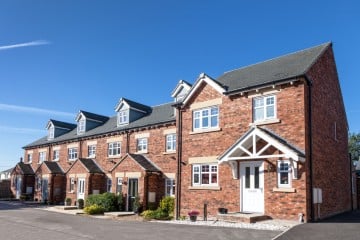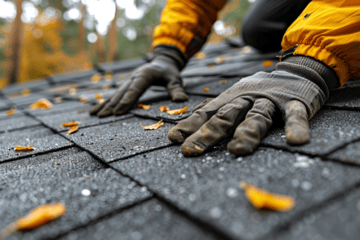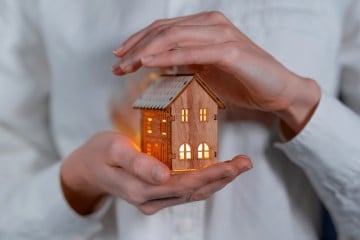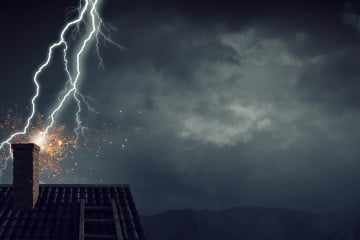What insurance is available?
There's no specific type of thatched roof insurance available - instead you're looking for non-standard home insurance. There are 2 types of insurance to choose from depending on your needs: buildings insurance and contents insurance.
Buildings insurance protects the structure of your home by helping you cover the cost of any repairs. This includes the walls, floor, ceiling and the thatched roof itself. It also helps cover the full rebuild cost of your home.
Contents insurance covers your personal possessions inside your home. It covers against theft, loss and damage caused by storms, fire and flood. There are 2 types of contents insurance: new-for-old and indemnity.
You can also choose to combine both buildings and contents insurance into a single policy. This can often work out cheaper than buying separate policies. According to our data*, a combined buildings and contents insurance policy is £201. But getting separate building and contents insurance policies would cost £209 and £60 respectively.
Finding home insurance for a building with a thatched roof works the same as any other property type. Due to the additional risk of having a thatched roof, you might find you have fewer offers to choose from, and those you do get might cost you more.
What am I protected against?
Non-standard home insurance for a thatched roof home is tailored to the increased risk of fire damage and the specialist skills needed to fix or replace it. With buildings insurance you're usually covered against damage from:
Burglary damage
This is where your home is damaged during a break-in, even if the burglar didn't manage to steal anything. You can help prevent theft in your home by having the right type of lock and also choosing the best type of burglar alarm.
Fire
Fire is particularly dangerous for a thatched roof building due to the highly flammable nature of the thatch. A fire can spread through a straw and/or reed thatch rapidly.
Flood and storm damage
Flooding and storms can be devastating to any building but a thatched roof home can be particularly troublesome. Thatch materials are more susceptible to extreme weather - for example, a bolt of lightning can quickly start fires in the thatch. Also, without the proper cover, you could find yourself landed with expensive repairs that only a specialist thatcher is capable of doing.
Are thatched roof houses more expensive to insure?
Yes. This is for a few reasons. The first is the obvious fire risk a thatched roof represents. You will pay more for buildings insurance due to this. However the average price of contents insurance for thatched properties is £64*. This £2* less than the standard average price of £66*.
A thatched roof building will also typically have more expensive repair and rebuild costs, which is something insurers take into consideration when calculating your costs. This is because of the materials needed and the specialist tradespeople for this type of work.
If you own a home with a thatched roof, it’s likely it could also be a listed building. This means there could be local or national guidelines on what to do if your home needs to be repaired. These restrictions mean it could be more expensive to get work done.
According to our data*, the average building insurance policy for a Grade I property is £648 while cover for a Grade II building is £555.
How can I reduce fire risk?
Book regular inspections
Get a qualified electrician to inspect your electrical wiring and fittings on a regular basis
Fit a fire barrier
A fire barrier coated with fire-resistant chemicals under the thatch could help reduce risk
Take professional measures
Professionally treat your thatch with fire retardant spray to reduce the risk of fire
Install smoke alarms
Having smoke alarms on all floors and in the roof space could help prevent disaster
Fit heat monitors
Fitting heat monitors on your wood burner means you'll get a warning if your flue is overheating
Look after your chimney
Keep your chimney clear with regular maintenance and make sure it's swept frequently
What our home insurance expert says
What do I need to get a quote?
Details about your thatched roof
Include details about your roof such as what it's made of, when it was last re-thatched, when it was last inspected and what condition it's currently in. Insurers generally want to know that your roof is well maintained, with fire risk being kept to a minimum.
When your house was built
The age of your property is important to know as, if your house is particularly old, your insurance quotes might be higher.
If your house is listed
Due to special or historic interest - your insurer will need to know if your home is a listed building, as they can be harder to repair.
What the exterior walls are made of
If your walls are made of special building materials such as wattle and daub, your insurer will need to know. As this is also considered non-standard construction.
The condition of the building
Your insurer will want to know the condition of your home, as in if there are any structural problems like damp or faulty wiring for example.
Whether your house has been underpinned
If your home has been underpinned or had the foundations reinforced should be detailed in your mortgage valuation or HomeBuyer Report
Signs or a history of subsidence
Subsistence is something your insurer will want to be aware of. It's more common in older homes as their foundations are often shallower than modern homes.
History of flooding
Insurers will want to know if there have been any previous floods. This refers to flooding from natural sources like rivers rather than burst pipes.
The rebuild cost of your home
The rebuild cost indicates how much a future home insurance claim might cost. Find out how to calculate your rebuild cost with our guide or use the free rebuild cost calculator from the Royal Institute of Chartered Surveyors (RICS) Building Cost Information Service (BCIS).
Pros and cons of owning a thatched cottage
The pros of owning a thatched roof home include:
- Thatched roofs look good and add character and novelty value to your home.
- Using plant materials for roofing is environmentally friendly.
- Thatched roofs have strong insulation properties, helping you keep warm in winter and cool in summer.
But of course there are cons to consider too:
- Thatched roofs can be expensive to install .
- They need more maintenance and regular inspections.
- Their increased fire risks mean you’ll need to consider safety measures.







